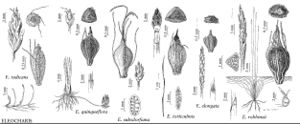Eleocharis robbinsii
Mag. Hort. Bot. 7: 178. 1841.
Plants perennial; rhizomes (0.5–) 1–2 mm thick, longer internodes 2–3 cm, scales 5–7 mm; tubers sometimes present, apical, ovoid, 4–8 × 3–4 mm. Culms acutely trigonous; spikelet-bearing culms 16–70 cm × 0.7–0.9 mm; when submersed plants often forming numerous, filiform, flaccid culms without spikelets, sometimes with whorls of slender branches, 0.1–0.3 mm wide; soft, sometimes septate-nodulose when aquatic, internally spongy, transverse septa incomplete. Leaves: distal leaf-sheaths persistent or decaying, membranous, apex obtuse to acuminate. Spikelets sometimes proliferous (when submerged), 9–33 × 1.5–3 mm; rachilla joints bearing prominent winglike remnants of floral scales; proximal scale with a flower, amplexicaulous, (5–) 6–9.8 mm; floral scales 4–18, 0.5–1 per mm of rachilla, stramineous to pale-brown, often minutely dotted reddish, without or rarely with darker submarginal band, narrowly ovate to lanceolate, 5–7.8 × 2–3 mm, thickly papery, membranous toward margins, apex narrowly rounded to acute. Flowers: perianth bristles 6–7, stramineous to reddish-brown, proximally slightly flattened, subequal to equal, much exceeding to rarely shorter than achene, 3–5 mm, retrorsely spinulose; anthers yellow to reddish, 1.6–3.2 mm; styles 3-fid. Achenes stramineous or medium brown, biconvex or compressed trigonous, narrowly obpyriform, 1.9–2.6 × 1–1.4 mm, adaxial face with 15–22 rows of rectangular, transversely elongated or nearly isodiametric cells, clearly sculptured at 10–15X, apex usually conspicuously constricted to short neck 0.4–0.7 mm wide, usually wider at tubercle base. Tubercles stramineous to medium brown, high-pyramidal, 0.5–1.1 × 0.3–0.7 mm.
Phenology: Fruiting late spring–late fall.
Habitat: Shallow waters of fresh lakes and ponds with sandy-peaty soils
Elevation: 10–500 m
Distribution

N.B., N.S., Ont., Que., Ala., Conn., Del., Fla., Ga., Maine, Mass., Mich., Minn., N.H., N.J., N.C., Ohio, S.C., Va., Wis.
Discussion
I have not seen voucher specimens for literature reports of Eleocharis robbinsii from Indiana, Pennsylvania, or Rhode Island. Plants from South Carolina with the achene surface cells nearly isodiametric, the achene apex spongy, and the anthers to 3.2 mm may represent an undescribed taxon.
Selected References
None.
Lower Taxa
"shortened" is not a number."wider" is not a number.
